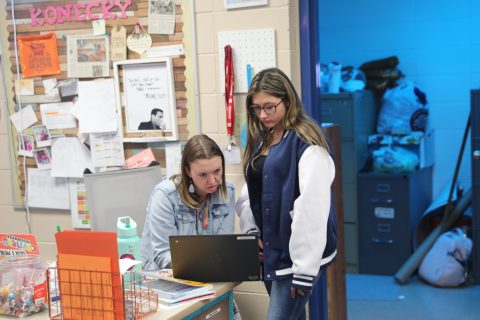Yearbooks remain a fantastic way for schools to remember peak moments of the school year. Students look forward to signing the autograph pages as well as seeing themselves and their favorite memories celebrated throughout the pages. But creating an unforgettable yearbook requires a dedicated staff who can bring your ideas to life. To best equip your tribe with the tools they need to succeed, you need an organized yearbook classroom.
A well-organized yearbook classroom lays the foundation for effective teaching and learning. We want to help you set the tone for an amazing school year. We compiled a list of seven tips from Walsworth advisers to help optimize your classroom layout, simplify processes and cultivate a peaceful atmosphere that fosters student engagement and success.
Let’s explore what advisers Beth Herrick of Northwest Guilford High School and Casey Elsa of Santa Rosa High School say it takes to maintain a fun, organized and inspiring yearbook classroom.
1. Prep Your Supplies
By using labeled supplies like binders, writing utensils and bins in your classroom, you can save time and make processes more efficient. Herrick found that gathering the right supplies at the start of the school year helps maintain an organized yearbook classroom. To facilitate this, she maintains a shelf with 1″ binders for each student, serving as their “staff manual.” This manual contains information like policies, important dates, Style Guides, faculty information and more.
“I have found that the more information I can provide the students with, the easier my job is as the adviser,” Herrick said.
2. Create a Schedule
Having a clear and visible schedule creates a structured learning environment, promotes a sense of responsibility and helps with time management. In Herrick’s classroom, she keeps a huge monthly calendar that she and her students write on using Expo markers. With a classroom schedule, students and teachers can keep track of important dates, assignments and more.
“It is critical to send photographers out to the earliest games. So, we start tracking those games right away on our calendar,” Herrick said.
Incorporating a calendar fosters effective communication among your yearbook staff, which enhances productivity.
3. Set Deadlines
Applying deadlines to student workloads is the best way to stay on top of things throughout the semester. In her classroom, Elsa finds that short deadlines mitigate procrastination. She allows no more than three weeks spent on a spread. Throughout that time, her editors assist other students.
“Have opportunities for the kids to recover if they fail to accomplish a spread. Every year, every deadline, a kid will fail. This is usually a tough lesson for some kids. Having a way for them to make up for the failing via an extra credit assignment or two, really is the way to go,” Elsa said.
Additionally, dividing the production process into segments per semester helps your staff tackle each project more effectively. Setting classroom deadlines instills accountability, helps save and prepares
4. Utilize Walsworth’s Resources
Utilizing Walsworth resources is a terrific way to stay organized. Take inspiration from our sample layouts, tutorials and more to maximize efficiency. At the beginning of each school year, Elsa finds it helpful to cover fundamental design techniques. She maintains a structured approach by allocating specific time slots for each task assigned to her students.
“We look at good designs and we try to imitate them using the Custom Templates on Walsworth’s Online Design,” Elsa said. “I assign everyone a single spread. The new people get partners. The old timers might work alone.”
Elsa also requires proof of progress and communication among her staff.
“I require that students submit a screenshot or picture of their page in its ‘Final Draft’ stage so that I know when it is done and how it looked before the editors changed it,” Elsa said. “This is the bulk of how I communicate the workflow and deadlines.”
Additionally, here are a few outside resources that are designed to help educators maintain organization inside and outside of the classroom:
- Trello – Trello is the go-to tool for effortless project organization. By using Trello, you can create boards to track tasks, team members and project progress all in one place.
- ClassDojo – ClassDojo enhances classroom-home connectivity, facilitating communication and sharing work. It offers photo/video sharing, messaging, translation support and real-time progress updates for teachers, students and families—for free.
- Nifty – Nifty is a remote collaboration hub where you can easily organize tasks, track goals, message team members, measure time and progress, consolidate files, proof items, get master overview of all projects, create visual roadmaps and more. Use this free project management tool to boost productivity, meet deadlines and save time.
5. Teamwork Makes the Dream Work
As the adviser, students should not rely solely on you – you already have enough on your plate! Instead, empower your staff to be self-sufficient. A project as big as school yearbook creation requires delegation.
“The more you can delegate as an adviser, the easier your yearbook will come together. It takes the entire staff to get the yearbook created, not just one overworked teacher,” Herrick said.
Involve your students by assigning specific responsibilities. This drives a sense of accountability, paving the way for an organized yearbook classroom and a smooth school year overall. For instance, Herrick demonstrates this by entrusting the photo editor with managing cameras, including check-ins and charging.
“Everything I do to keep the classroom organized involves an editor that is charge of it,” Herrick said. “It puts the responsibility in their hands, and it gives them ‘buy in.’ If they have some role or responsibility in the classroom, they are going to feel a sense of ownership and care more about what is going into the book.”
6. Build Community
A school yearbook would not be possible without a community of dedicated individuals. The key to building community is creating a safe space where everyone feels valued. There is no better way to engage students than to maintain a fun working environment. In Elsa’s yearbook classroom, she does this by hosting after-school work sessions where her students eat, play games and perfect their yearbook. By incorporating team building activities, your staff will grow closer as the school year progresses.
“Food is a great motivator,” Herrick said. “We also had a potluck before the December break along with a White Elephant gift exchange. We had everything from old Twilight posters to some of the ugliest cookie jars and trinkets ever. It is fun and funny.”
7. Encourage Leadership
Encouraging leadership within the classroom enhances confidence, independence and the ability to positively inspire others. It empowers students to take ownership of their learning, collaborate effectively and make informed decisions. Embrace the learning journey and extend grace to yourself and your staff.
“Give yourself some grace and know that everything is a learning experience for you and your staff members,” Herrick said. “The most important thing for me as the teacher is that I want everyone to feel important and welcome. I want our staff to feel like a ‘family.’ This takes time, but the best way I achieve this is that I teach students leadership. We all have strengths and weaknesses, and that is where teamwork is essential.”
Like a yearbook, nurturing a sense of belonging takes time. Teach your staff leadership and cultivate teamwork by praising their achievements as often as you correct their mistakes. This boosts morale and motivates everyone to work harder and support each other.
“Reward the good things. It could be a weekly shout out to a student or a team that is out taking great photos or someone who has made an awesome headline. I love hearing this! Praising the good things, they do will make the staff happier and want to work harder for you and each other.”
Key Takeaways
Organizing your yearbook classroom creates an engaging and successful working and learning environment. These tips from experienced Walsworth advisers emphasize the importance of preparation, delegating responsibilities, utilizing available resources and building community. Additionally, acknowledging accomplishments serves as a great motivator. While creating the perfect yearbook can be overwhelming, remind yourself the experience promotes personal growth – so have fun! Each of these steps contribute to building a strong yearbook.
Part of building a great yearbook is collaborating with other yearbook professionals to develop your yearbook program. Walsworth training events like Adviser Academy, Elite Weekend and summer workshops, all of which you can find on our Events page, offer additional tips for your classroom and networking opportunities to connect with other advisers. Let us know what works for your yearbook classroom in the comments below!





